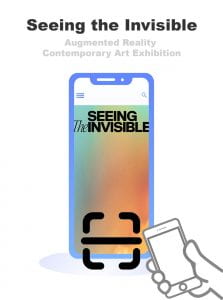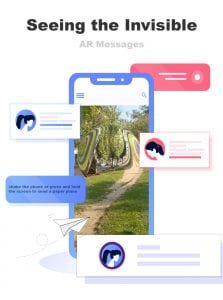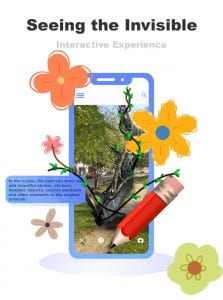My app is a derived product from the exhibition and is updated based on the original. The exhibition of “Seeing the Invisible” is the most ambitious and expansive exhibition to date of contemporary artworks created with AR technology and exhibited in 12 botanical gardens in six countries including Australia, Canada, Israel, South Africa, Britain and the United States for one year at the same time. Addressing themes of nature, the environment and sustainability, and exploring the boundaries and connections between art, technology and nature, the exhibition features 13 immersive virtual works by established.
The idea was born out of the pandemic and the purpose through the virtual interactions and use of mobile media to engage the public back to the outdoor to have fun with friends and family. Because during the period of COVID-19, we have increased our appetite for virtual interactions and for the great outdoors, because the only entertainment is electronic and we wish to go outside. This exhibition combines both. Tal Michael Haring has mentioned, “Coming out of the pandemic when outdoor experiences and nature have taken on a new meaning and gravity in our lives, this exhibition represents a fresh way for people to engage with art and nature simultaneously.” (Seeing the Invisible was co-curated by Hadas Maor and Tal Michael Haring. )
In fact, the key concern of the exhibition presenting which is the same as the studio’s consideration of some key questions. Both mentioned how to better reactivate the city through mobile media and how to use mobile media to engage audiences and the public in alternative and playful ways. However, the app is present well the to those points and is also the way that I hope my final work engages the audience.
To improve and enhance the interactivity function of the original app, I have added two functions: social and gaming function. The first one is the AR message chat, Users can send AR messages and use the paper airplane function to launch in the specified direction. The paper airplane will be received by different users all over the world. At the same time, users can also view and reply to paper airplanes thrown by others which makes chatting more novel and interesting. Actually, the augmented reality is not a new function appearing in the social media. An app called Spotselfie has been using AR to enhance the online experience by blurring the divide between the real and virtual world. Besides, Tom Jones argues that AR technology can enhance sociality and many social media users see AR as a fun and engaging tool, particularly in the way we new communicate and interact as a society. The second function is that the user can take the artist’s work as the drawing board, and the application has provided an opportunity for the user to make the second creation of the work with the artist on the original art product. After publishing in the community, others can see the graffiti when they come across this artwork, and they can also re-create it on this basis. Although, I have mentioned that I do not want to develop the function of the game interaction, because I hope the visitors can focus more on the artists’ works. Therefore, in order to enhance more diverse experiences and also consider bringing the visitors’ immersive experiences to a new level, which derive this idea: the users can become more immersed in the artwork through the process of creation, it not only increases the enjoyment, but also keeps the audience paying attention to the exhibition, make every user as a soul artist.
Furthermore, to be honest, I don’t think that it is necessary to extend or improve the application. First, my application has already been extended from the original one. It has added a social contact function and interactive experience function. Second, this application is derived product from the exhibition, therefore the core things should be the exhibition itself and from my point of view, we should keep focusing on that not change it.
The next part is about the application’s target audience. although there is no any restrictions on age and gender, but I still want more users aged can be around 18-35. The reason is because of for this group of young people, the purpose of socializing is to pass the time. They value social experience rather than efficiency. There are many ways for strangers to socialize and the AR technology is adopted is that it is novel and fun, which can make the social experience more interesting and colorful. Second is the location of user, here only can be the six countries, because the exhibition is only exhibited in that country. the last part is about use’s interest, I’m listing 5 tags for this part: fans, ART, picture, family, and nature. Those tags is clear show what kind of people will attract with this exhibition and download the application.
From the definition to understand collaboration is a working practice whereby individuals work together for a common purpose to achieve business benefit. Collaboration enables individuals to work together to achieve a defined and common business purpose. However, about the skill improve of collaboration in this semester, personally, I am very thankful for this studio give the studies model. Because of the pandemic, our studio is online model which help us rapidly get into the state, it break the embarrassed and make us feel ease to communication, increase the efficient. Besides that, the biggest change for me is I have learn about active listening and tries to feel what the speaker is feeling. It is very important skill for me, the effective listening creates understanding that builds productivity and pay more attentive is observing without distraction. Which means putting my goals and arguments on hold.
In conclusion, With the development of technology, AR technology will be more commonly used in the future of our life, and make our life become more colourful and meaningful. Just same as this time, by using the interesting way to encourage us back to the outdoor to have fun after the pandemic.
Reflection:
Arghashi V and Yuksel CA,. 2022. Interactivity, Inspiration, and Perceived Usefulness! How retailers’ AR-apps improve consumer engagement through flow. [online] Science Direct. Available at: <https://www.sciencedirect.com/science/article/abs/pii/S0969698921003222>
Botteron, A., 2022. Cities must prepare for a new post-pandemic normal – Resilient Cities Network. [online] Resilient Cities Network. Available at: <https://resilientcitiesnetwork.org/urban_resiliences/cities-must-prepare-for-a-new-post-pandemic-normal/> [Accessed 9 May 2022].
Bitgood, S., 1992. The Anatomy of An Exhibit. [online] Visitor Behaviour. Available at: <chrome-extension://ikhdkkncnoglghljlkmcimlnlhkeamad/pdf-viewer/web/viewer.html?file=https%3A%2F%2Fwww.informalscience.org%2Fsites%2Fdefault%2Ffiles%2FVSA-a0a1v7-a_5730.pdf>
Coates, C., 2022. How Museums are using Augmented Reality. [online] MuseumNext. Available at: <https://www.museumnext.com/article/how-museums-are-using-augmented-reality/> [Accessed 4 May 2022].
Lanson, K., de Souza e Silva, A. and Hjorth, L., 2022. the routledge companion to mobile media art Free Download. [online] Husamzalloum.net. Available at: <https://www.husamzalloum.net/file/the-routledge-companion-to-mobile-media-art/> [Accessed 18 March 2022].
Makoto Manabe & Lois Lydens. 2007. Making Connections: Using Mobile Phones as a Museum Tool, Journal of Museum Education, 32:1, 27-34, DOI: 10.1080/10598650.2007.11510555



